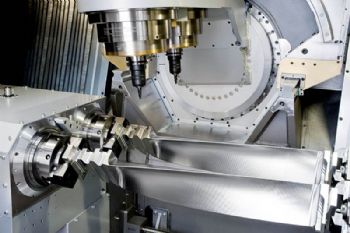
GF Machining Solutions’ (
www.gfms.com) new Liechti Turbomill 1400 g is said to offer a solution for roughing and finishing blades up to 1.4m long.
Critical aerospace-engine turbine-fan blades and high-bypass turbines produce much of an aircraft’s forward thrust; in the past, precision-forged blades needed only light finishing operations to achieve the tolerances required.
However, the growing demand for greater fuel efficiency has led to tighter tolerances, and many blades now start out as over-size forgings and have to be machined to their final net shape.
Blades have typically been machined from titanium alloys, but newer blade materials include aluminium and carbon-fibre composites.
Carbon-fibre blades have titanium leading edges attached to the relatively brittle composite material to minimise the damage if an engine ingests a foreign object.
The Liechti Turbomill 1400 g is described as an advanced turbine blade machine designed for fast, cost-efficient production of medium-to-large blades for jet engines and power generation.
The machine’s configuration means that blades are clamped at each end of the machine and rotated between centres while a milling tool performs cutting operations.
The motion creates complex airfoil contours, allowing the machine to perform heavy-duty roughing and dynamic finishing for the airfoil, root form, and shroud.
The machine rapidly creates complex profiles on the leading and trailing edges of the blades that control airflow into the engine while maintaining the tight tolerances that maximise fuel efficiency (some machine tools can start and stop simple straight-line machine movements at 2g — the Turbomill 1400 g performs accurate three-dimensional machining at 1g).
Acceleration and deceleration at 1g generate significant force — strong enough to topple the machine over if it is not securely anchored to the floor.
The Liechti Turbomill 1400 g uses its large size, weight, and rigidity to resist these forces. Machine ways are engineered with the strength to handle extreme momentum and inertia.
The X-axis moves via a linear drive, the Y- and Z-axis on ball screws, and direct-drive motors power the rotary B- and A- axes, which is key to moving tools quickly around a blade’s leading and trailing edges.
The Liechti Turbomill 1400 g is aimed at OEMs and large Tier One manufacturers involved in high-volume turbine blade production — and is able to machine blades twice as fast as conventional and multi-purpose machines.